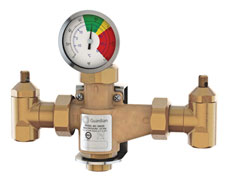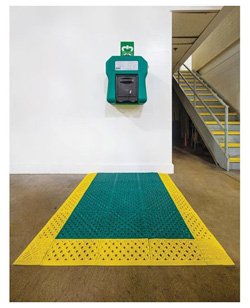| The Home page of ILPI's Safety Data Sheet (SDS) Resource, the leader in SDS information since 1995! | |
| The history and philosophy behind this resource. | |
| A curated collection of books and reference materials concerning Safety Data Sheets and closely related topics. | |
| Paste your plain text SDS into the SDS-Demystifier, and it will be converted into a hypertext-enriched document with links to detailed explanations of each key term. | |
| An extensive list of frequently asked questions about Safety Data Sheets including regulations, content, compliance, and more. | |
| A humorous take on Safety Data Sheet jargon. Fill in the blanks on our entry form to generate a personalized Unsafety Data Sheet to share with your coworkers. | |
| Since 1995, we've maintained this massive curated list of the best places to find Safety Data Sheets on the Internet. | |
| Way more than a glossary, this hypertext-enhanced resource covers hundreds of SDS-related terms and expert knowledge. Each entry includes both the SDS relevance and links to additional authoritative resources. | |
| Archived results of Safety Data Sheet related polls taken by some of our millions of site visitors | |
| You are here! The OSHA regulations behind SDS regulations, including the inspection guidelines and over 400 official interpretations letters under the Hazard Communication Standard | |
| Commercial suppliers of SDS authoring and management software as well as cloud compliance services. | |
| Commercial companies that will create SDS's for your specific needs as well as SDS translation companies. |

Safety signs, banners, and scoreboards? Get yours at Safety Emporium!
| Title: 01/11/2024 - Emergency eyewash protection when exposed to 0.1 percent or greater formaldehyde | |
| Record Type: Interpretation | Standard Number: 1910.1048, 1910.1048(i)(2), 1910.1048(i)(3), 1910.1048(m)(1)(i), 1910.1048(m)(1)(ii), 1910.1048(m)(1)(iv), 1910.1200 |
OSHA requirements are set by statute, standards and regulations. Our interpretation letters explain these requirements and how they apply to particular circumstances, but they cannot create additional employer obligations. This letter constitutes OSHA's interpretation of the requirements discussed. Note that our enforcement guidance may be affected by changes to OSHA rules. Also, from time to time we update our guidance in response to new information. To keep apprised of such developments, you can consult OSHA's website at https://www.osha.gov.
January 11, 2024

Protect your workers with ADA-compliant safety stations from Safety Emporium.
Mr. Kevin Heym
University of Pennsylvania Health System
3600 Civic Center Blvd. - 3rd Floor
Philadelphia, PA 19104
Dear Mr. Heym:
Thank you for your inquiry to the Occupational Safety and Health Administration's (OSHA) Directorate of Enforcement Programs, regarding clarification of "acceptable eyewash facilities" under OSHA's Formaldehyde standard, 29 CFR § 1910.1048. This letter constitutes OSHA's interpretation only of the requirements herein and may not be applicable to any situation not delineated within your original inquiry. Your questions have been summarized below, followed by our responses.
Background: Your inquiry regards providing acceptable emergency use eyewash facilities within the immediate work area for employees working with solutions containing 0.1 percent or greater formaldehyde. Specifically, you request guidance on acceptable emergency eyewash facilities when using commercially prepared 3-5% neutral buffered formalin in small 15 milliliters (ml) or 45 ml containers to collect patient tissue samples in a hospital setting.
When we asked for additional information, your follow-up correspondence stated that your hospital has installed emergency eyewashes in your labs, operating rooms, and other areas where dispensing of formalin occurs, and large quantities are being handled. However, your question concerns the other areas of your hospital where small tissue samples are taken and placed into small, prefilled formalin specimen containers for eventual lab analysis. The areas include, but are not limited to, patient exam rooms, primarily in departments like dermatology, dental, and other areas.
Question 1: Is the 0.1 percent or greater formaldehyde threshold that triggers the eyewash requirements of the standard expressed as a percent by volume or percent by weight?
Response: OSHA's Formaldehyde standard, at paragraph 1910.1048(i)(3), provides that, [i]f there is any possibility that an employee's eyes may be splashed with solutions containing 0.1 percent or greater formaldehyde, the employer shall provide acceptable eyewash facilities within the immediate work area for emergency use.
This requirement applies to splashes from liquids or solutions containing 0.1 percent or greater formaldehyde. The commercial buffered formalin solution for holding tissue samples, described in your inquiry is a liquid mixture or solution containing 3-5 percent formaldehyde therefore use of this product must comply with the Formaldehyde standard's eyewash requirement.
When classifying any chemical mixture (gas, solid, or liquid) containing formaldehyde, manufacturers, importers, and distributors must comply with OSHA's Hazard Communication standard, 29 CFR § 1910.1200, and must classify all mixtures or solutions composed of greater than 0.1 percent formaldehyde for several hazards, including eye irritation. See 29 CFR § 1910.1048(m)(1)(i) - (ii), (iv).
OSHA's Hazard Communication standard requires that, when testing has not been done on a mixture and the mixture's classification is based on the percent of a hazardous chemical in a mixture, that hazard classification is to be based on the percent of a mixture either by weight or volume. See 77 Fed. Reg. 17574, 17706 (Mar. 26, 2012). Where employees may be potentially exposed to either a formaldehyde gas mixture or a formaldehyde solution, the manufacturer's safety data sheet (SDS) may recommend use of eyewashes based on the percent of formaldehyde by volume or by weight, respectively. For additional information, please see the OSHA Fact Sheet on Formaldehyde (OSHA FS - 2011)."

Ensure your eyewashes and safety showers meet the ANSI tepid water requirement with thermostatic mixing valves from Safety Emporium.
Question 2: Why does the threshold terminology change from "1 percent" as related to skin exposure to "0.1 percent" for eye exposure?
Response: While the Formaldehyde standard requires eyewash facilities if an employee's eyes may be splashed with solutions containing 0.1 percent or greater formaldehyde, the standard at paragraph 1910.1048(i)(2) requires the employer provide conveniently located quick drench showers [i]f employees' skin may become splashed with solutions containing 1 percent or greater formaldehyde.
As OSHA explained during the Formaldehyde standard rulemaking, the evidence in the record indicated that skin hazards from splashes and spills were less severe than the potential injury from an eye splash. See 52 Fed. Reg. 46168, 46273 (Dec. 4, 1987).
Question 3: Is the requirement for installing emergency eyewash stations triggered when neutral buffered formalin solution with 3-5 percent formaldehyde is used in small quantities (e.g., 15 ml or 45 ml) and has a minimal splashing likelihood? Instead of emergency eyewash stations, can emergency flush bottles be made available in case of splashes until more substantial eye flushing stations can be reached?
Response: The Formaldehyde standard's hygiene protection requirements at paragraph 1910.1048(i) require employers to provide quick-drench showers if employees may become splashed with solutions containing 1 percent or greater formaldehyde (paragraph (i)(2)). Additionally, paragraph (i)(3) requires employers to provide acceptable eyewash facilities if there is any possibility that an employee's eyes may be splashed with solutions containing 0.1 percent or greater formaldehyde. However, OSHA cannot directly answer your questions regarding a specific scenario because it depends on the circumstances and settings.
As your letter noted, OSHA has previously stated that for small spills, a faucet or small hand-held unit could be used, provided that all affected parts could be reached. Similarly, for eyewashes, units may be portable if they permit the eye to be flushed for at least 15 minutes. For this reason, bottle-type eyewashes are not an acceptable alternative to a 15-minute eyewash. However, the interim aid provided with a smaller amount of eyewash from a bottle in certain situations - that an employer would evaluate in their hazard analysis - may provide temporary relief to allow an injured employee to get to a nearby approved eyewash station (see OSHA letter to Robert Schumate, Nov. 6, 2020). The degree of sophistication of the emergency device varies with the size of the potential splash.

Delineate your eye wash and safety shower locations with floor marking solutions from Safety Emporium.
OSHA has provided similar guidance in its compliance directive on the Formaldehyde standard, CPL 02-02-052, October 7, 1991, and that directive's Appendix C contains nonmandatory evaluation criteria for emergency showers and eyewashes.1 This appendix discusses recommended locations for eyewash units and references the American National Standard for Emergency Eyewash and Shower Equipment, ANSI Z358.1. Note, ANSI Z358.1-2014, Section 8, describes personal eyewash units and states they shall provide immediate flushing to support plumbed and self-contained emergency eyewash… equipment but shall not replace them.
For more general information, OSHA has a Formaldehyde safety and health topics page, www.osha.gov/formaldehyde/standards, that provides references for hazard recognition, evaluating exposures, and enforcement procedures. Additionally, OSHA has a webpage with general Recommended Practices for Safety and Health Programs, available at www.osha.gov/safety-management/hazard-Identification, that provides resources and references for hazard identification and assessment.
Thank you for your interest in occupational safety and health. I hope you find this information helpful. OSHA's requirements are set by statute, standards, and regulations. Letters of interpretation do not create new or additional requirements but rather explain these requirements and how they apply to particular circumstances. This letter constitutes OSHA's interpretation of the requirements discussed. From time to time, letters are affected when the agency updates a standard, a legal decision impacts a standard, or changes in technology affect the interpretation. To ensure that you are using the correct information and guidance, please consult OSHA's website at www.osha.gov. If you have further questions, please feel free to contact the Office of Health Enforcement at (202) 693-2190.
Sincerely,
Kimberly A. Stille, Director
Directorate of Enforcement Programs
1See https://www.osha.gov/enforcement/directives/cpl-02-02-052.
The original official public domain version of this document is available from OSHA at https://www.osha.gov/laws-regs/standardinterpretations/2024-01-11.